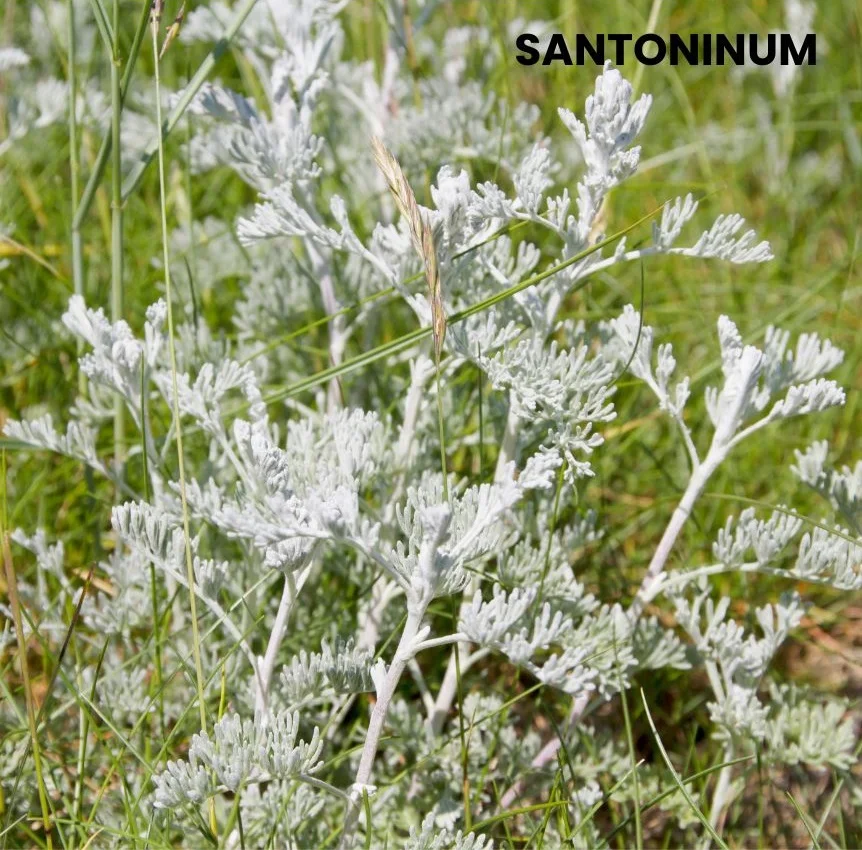Santonin is the active principle derived from Santonica, specifically the unexpanded flower heads of Artemisia Maritima, commonly known as Cina.
This remedy is renowned for its efficacy in treating worm infestations and addressing various symptoms related to the eyes and urinary tract.

SOURCE INFORMATION
Scientific Classification
- Kingdom: Plantae
- Order: Asterales
- Family: Asteraceae
- Genus: Artemisia
- Species: Artemisia maritima
Origin
- Santonin is derived from the flower heads of Artemisia Maritima, a plant found in Europe and parts of Asia.
- Historically, it has been used for its anthelmintic (worm-expelling) properties.
Historical Facts
- The use of Santoninum dates back to ancient times when herbal remedies were the primary treatment for parasitic infections.
- It was especially valued for its ability to expel intestinal worms, particularly Ascaris lumbricoides (roundworms) and threadworms.
- Over time, its use expanded to treat a variety of other conditions, particularly those affecting the eyes and urinary system.
DRUG PATHOGENESIS
- Santoninum primarily affects the gastrointestinal, urinary, and nervous systems.
- Its most significant actions include alleviating worm infestations, reducing gastrointestinal irritation, and treating urinary issues.
- It also has notable effects on the eyes, causing and treating various visual disturbances.
KEY CHARACTERISTICS
- Effective in treating worm infestations, particularly Ascaris lumbricoides and threadworms (not effective against tapeworms).
- Eye symptoms: sudden dimness of sight, colour blindness (Xanthopsia), and dark rings around the eyes.
- Urinary symptoms: greenish urine if acidic and reddish-purple if alkaline, incontinence, dysuria (painful urination), and nephritis.
- Other symptoms: occipital headache, itching of the nose, restless sleep, twitching of muscles, chronic cystitis, and laryngeal crises in tabes dorsalis.
DETAILED ORGAN SYMPTOMS
HEAD
- Occipital Headache with Chromatic Hallucinations: Pain at the back of the head, often accompanied by visual hallucinations of colors that aren’t there.
- Intense Itching of the Nose: Causes the patient to dig or bore into the nostrils due to severe discomfort.
EYES
- Sudden and Temporary Dimness of Vision: Episodes where vision suddenly becomes blurry or unclear.
- Color Blindness (Xanthopsia): A condition where objects are seen with a yellow tint.
- Strabismus Due to Worm Infestation: Crossed eyes caused by the presence of worms.
- Dark Rings Around the Eyes: Notable discoloration or dark circles under the eyes.
MOUTH
- Fetid Breath: Noticeably bad breath.
- Depraved Appetite: Unusual eating habits, sometimes craving non-food items.
- Increased Thirst: A constant need to drink fluids.
- Deep-Red Tongue: The tongue appears unusually red.
- Grinding of Teeth: Often occurs during sleep, causing dental and jaw issues.
- Nausea that Improves After Eating: Feeling of sickness that subsides upon consuming food.
- Choking Sensation in the Throat: A feeling of something being stuck in the throat, making it hard to swallow or breathe comfortably.
URINARY
- Changes in Urine Color: Urine may appear greenish if it is acidic and reddish-purple if it is alkaline.
- Incontinence and Dysuria: Difficulty controlling urination and painful urination.
- Enuresis: Bedwetting, particularly in children.
- Sensation of Fullness in the Bladder: A constant feeling of needing to urinate due to perceived fullness.
- Nephritis: Inflammation of the kidneys, which can cause pain and urinary issues.
MODALITIES
- Symptoms worsen at night.
- Worm-related symptoms are particularly prominent in children.
RELATIONSHIP WITH OTHER DRUGS
- Compare with: Cina, Teucrium, Naphthalinum, Natrum phosphoricum, Spigelia.
DOSE
- The recommended potency is the second to third trituration.
- Lower potencies can be toxic, so caution is advised.
- Santoninum should not be given to children with fever or constipation.
Frequently Asked Questions (FAQs)
What are the primary uses of Santoninum?
- Santoninum is primarily used to treat worm infestations, particularly roundworms and threadworms.
- It also addresses various symptoms related to the eyes and urinary system.
Can Santoninum treat tapeworms?
- No, Santoninum is not effective against tapeworms.
- It is primarily used for roundworms and threadworms.
What are the notable side effects of Santoninum?
- Notable side effects include chromatic hallucinations, color blindness (Xanthopsia), and changes in urine color.
- In toxic doses, it can cause severe symptoms and should be used with caution.
How should Santoninum be administered?
- Santoninum is typically administered in the second to third trituration.
- Lower potencies can be toxic, so it is important to follow the dosage instructions provided by a qualified homeopath.
Are there any conditions under which Santoninum should not be given?
- Santoninum should not be given to children with fever or constipation.
Meaning of Difficult Words
- Santonin: The active chemical compound derived from the plant Santonica.
- Anthelmintic: A substance that expels or destroys parasitic worms.
- Ascaris lumbricoides: A species of roundworm that infects the intestines of humans.
- Tabes dorsalis: A slow degeneration of the sensory neurons that carry information to the brain, often associated with syphilis.
- Occipital: Pertaining to the back part of the head.
- Xanthopsia: A visual condition where objects appear yellow.
- Strabismus: A condition where the eyes do not properly align with each other when looking at an object.
- Dysuria: Painful or difficult urination.
- Enuresis: Bedwetting.
- Nephritis: Inflammation of the kidneys.
- Chromatic hallucinations: Seeing colours that are not present.
